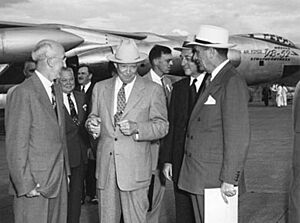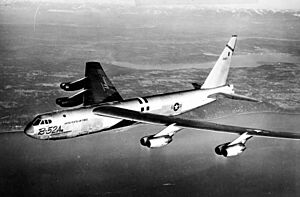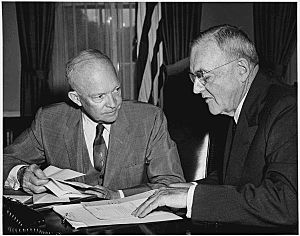New Look (policy) facts for kids
The New Look was a special plan for how the United States would protect itself during the Cold War. This plan was created by President Dwight D. Eisenhower when he was in charge. He wanted to make sure the U.S. was strong enough to face threats. But he also wanted to be careful with the country's money.
So, the New Look plan focused a lot on using powerful nuclear weapons. It also changed how regular armies worked. The main goal was to stop any attacks, big or small. These threats could come from the Soviet Union and its allies, known as the Eastern Bloc.
Contents
How Did the New Look Policy Start?

The New Look policy was first seen in the budget for the United States Department of Defense. This was for the year 1955. It was the first defense budget planned entirely by Eisenhower's military leaders.
Eisenhower and his closest advisors started thinking about this plan in 1952. They looked closely at what the U.S. military needed. The plan became official in a document called NSC 162/2. President Eisenhower approved it on October 30, 1953.
Why Use Nuclear Weapons More?
President Eisenhower believed that small nuclear weapons could be used like regular bullets. He said they were fine for military targets. The NSC 162/2 document showed Eisenhower's idea for long-term security. He wanted to keep the military ready without hurting the U.S. economy.
This was different from an earlier plan called NSC 68. That plan thought the Soviet Union would be strongest in the mid-1950s. Eisenhower disagreed. He thought the Soviet threat would always be there, both militarily and economically.
He wanted to avoid spending too much money on defense. He worried that smaller fights, like the Korean War, could drain U.S. money.
Secret Missions and Spying
The New Look policy also used more secret operations. These were missions done in secret, often by spies. These secret forces were cheaper than big armies. Also, secret methods seemed right to use during the Cold War.
One example was the Special Atomic Demolition Munition (SADM) program. This program used small, portable nuclear weapons. Special U.S. commandos, called Green Light Teams, were trained for these missions. They practiced carrying real nuclear weapons. Their job was to sneak into enemy areas, set off the weapons, and then leave. Sometimes, these missions were so dangerous that the commandos knew they might not come back.
Fighting with Ideas: Propaganda
Another part of the New Look was using "psychological warfare." This was a non-violent way to fight the Soviets. Eisenhower liked this idea a lot. The goal was to spread anti-Soviet messages in Communist countries. This was meant to change people's minds.
What Was "Massive Retaliation"?

To save money on defense, the New Look changed things. It focused less on regular armies and navies. Instead, it put more effort into "air-atomic" power. This meant using the Strategic Air Command, which had long-range bombers. Land and sea forces were made smaller.
This focus on air power became the main idea for U.S. safety. It was called "Massive Retaliation." This idea was summed up as "more bang for the buck." It meant getting more defense for less money. Massive Retaliation was meant to stop enemies from attacking. If an attack did happen, it would be a huge response.
Secretary of State John Foster Dulles explained this idea in 1954. He said that local defenses needed the added threat of "massive retaliatory power." He meant that the U.S. could respond strongly anywhere, using its own chosen methods.
Dulles said this allowed the military to focus its efforts. Instead of being ready for many different kinds of attacks, they could choose their best military tools. This way, he believed, the U.S. could get more security for less money.
Why Some People Criticized Massive Retaliation
Dulles suggested that if the Soviet Union supported a regular attack anywhere, the U.S. might hit the Soviet Union itself with nuclear weapons. But some historians, like John Lewis Gaddis, criticized this idea. They said it wasn't believable for smaller problems. For example, when the Soviets intervened in the Hungarian Revolution of 1956 in 1956, the U.S. didn't use nuclear weapons.
Critics also worried that as the Soviet Union got stronger, the threat of Massive Retaliation would seem less serious. They also thought it might make the Soviet Union want to strike first. This would be to try and destroy U.S. nuclear weapons before the U.S. could use them.
A "New" New Look Emerges
The U.S. did not stop France from losing to the Communist-led Viet Minh in Vietnam. This happened at the Battle of Ðiện Biên Phủ. This battle took place just four months after Dulles's speech. It showed how hard it was for Eisenhower to get involved in Asia. He wanted to avoid another "hot war" for the U.S.
Eisenhower decided not to use air strikes at Dien Bien Phu. Instead, he considered a third option. This was a threat of nuclear strikes against important Chinese targets. This was in line with the "Massive Retaliation" idea. This plan was approved in May, but only if Congress and U.S. allies agreed.
However, this tactic couldn't always protect U.S. interests. So, defense planners started to change the New Look. This "new" New Look focused on having "enough" strategic power, not necessarily being completely superior. It also focused on using tactical nuclear weapons for "limited wars." And it put more emphasis on standing armies instead of reserves.
Nuclear weapons were still the main focus, and saving money was still important. But this was a step towards what would later be called "flexible response." This new approach was written down in a document called NSC 5440 (approved as NSC 5501 in January 1955).
This document said that being able to use force in different ways would be important. It would help the free world resist attacks. As the fear of nuclear war grew, the U.S. and its allies couldn't be forced to choose. They didn't want to choose between not responding to a small attack or using force that might cause a huge nuclear war.
However, the U.S. also couldn't stop itself from using nuclear weapons, even in a small situation. This would be if it helped U.S. security the most. In the end, if faced with a choice, the U.S. had to be ready to take risks for its safety.
Historian Campbell Craig said that NSC 5440 was a big change. It moved away from Massive Retaliation. It clearly explained the "flexible response" strategy. And it predicted the challenges the Eisenhower administration would face later.



